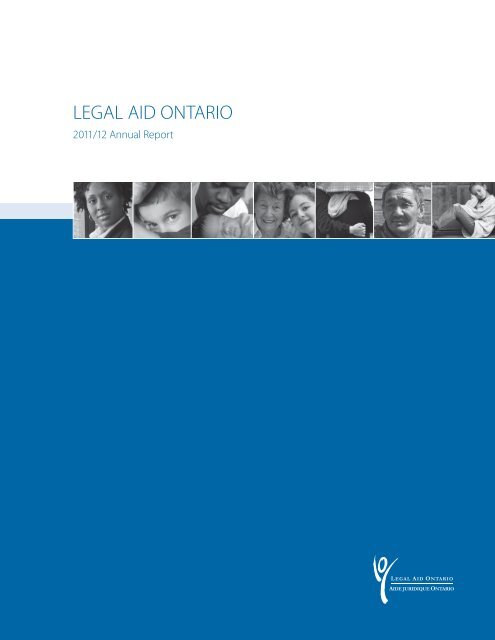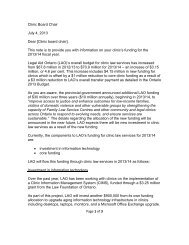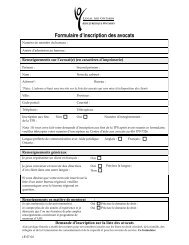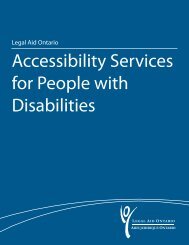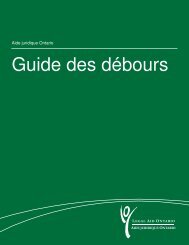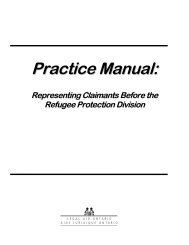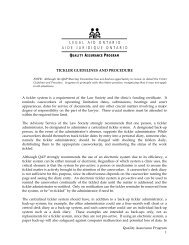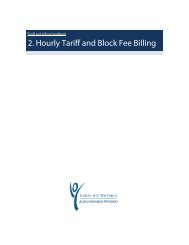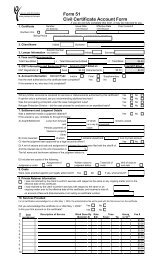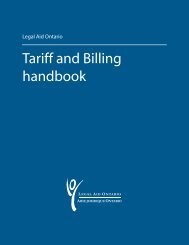2011/2012 Annual Report - Legal Aid Ontario
2011/2012 Annual Report - Legal Aid Ontario
2011/2012 Annual Report - Legal Aid Ontario
You also want an ePaper? Increase the reach of your titles
YUMPU automatically turns print PDFs into web optimized ePapers that Google loves.
legal aid ontario<br />
<strong>2011</strong>/12 <strong>Annual</strong> <strong>Report</strong>
table of contents<br />
4 Letter to the Minister<br />
5 Message from the Chair<br />
6 Message from the President<br />
7 Statutory Mandate<br />
7 Our Vision<br />
8 Our Values<br />
9 LAO Board of Directors<br />
10 About <strong>Legal</strong> <strong>Aid</strong><br />
11 Overview of Programs and Activities<br />
12 <strong>2011</strong>/12 In Focus<br />
15 <strong>Report</strong> on Client Services<br />
22 Financial Statements for <strong>Legal</strong> <strong>Aid</strong> <strong>Ontario</strong><br />
42 Management Discussion and Analysis<br />
<strong>2011</strong>/<strong>2012</strong> ANNUAL REPORT | 3
Letter to the Minister<br />
July 2, <strong>2012</strong><br />
The Honourable John Gerretsen<br />
Attorney General of <strong>Ontario</strong><br />
720 Bay Street<br />
Toronto, <strong>Ontario</strong> M5G 2K1<br />
Dear Minister,<br />
Please accept, in accordance with Section 72 of the <strong>Legal</strong> <strong>Aid</strong> Services Act, 1998, the <strong>Annual</strong> <strong>Report</strong><br />
for <strong>Legal</strong> <strong>Aid</strong> <strong>Ontario</strong> for the year ended March 31, <strong>2012</strong>.<br />
On behalf of the Board of Directors, management and staff of LAO, I would like to convey our<br />
appreciation to the Government of <strong>Ontario</strong> for its ongoing support of access to justice for<br />
low-income Ontarians.<br />
Yours sincerely,<br />
John D. McCamus, Chair<br />
<strong>Legal</strong> <strong>Aid</strong> <strong>Ontario</strong><br />
4 | LEGAL AID ONTARIO
Message from the Chair<br />
<strong>2011</strong>/12 was an important and successful year in advancing<br />
<strong>Legal</strong> <strong>Aid</strong> <strong>Ontario</strong>’s modernization plan. This year LAO provided<br />
legal aid support to over 1 million clients more innovatively and<br />
through more service channels than ever before, while tackling<br />
financial and legislative challenges. Program results are<br />
confirming that LAO is set in the right direction and the Board<br />
of Directors and I are very proud of this year’s accomplishments.<br />
LAO has significantly enhanced its goal to offer greater<br />
flexibility in its services, tailoring them to better meet clients’<br />
needs. For example, LAO’s enhanced duty counsel program<br />
uses a combination of staff and private bar to represent clients<br />
who do not have a lawyer at court and this year again saw<br />
an increase in the number of assists performed that move<br />
cases towards final resolution. Duty counsel are now better<br />
supported by court workers so that they may focus on<br />
value-added activities.<br />
LAO has also broadened its telephone-based legal advice for<br />
clients through the Client Service Centre (CSC), where staff<br />
lawyers provided over 23,000 assists in family law alone last<br />
year. Sixty per cent of calls were resolved with public legal<br />
information, access to justice referrals, referrals to community<br />
legal clinics and other service providers and the completion<br />
of basic client transactions. Forty per cent of callers received<br />
additional specialized services from the CSC – an increase of<br />
26% since August <strong>2011</strong>, with the provision of general legal<br />
information about family law and client preparation through<br />
Summary <strong>Legal</strong> Advice.<br />
Clients can also now find family law information on <strong>Legal</strong><br />
<strong>Aid</strong>’s Family Law Information Program (FLIP) which made<br />
enhancements in <strong>2011</strong>/12 to support clients unable to attend<br />
in-person sessions of the mandatory information program.<br />
Furthermore, criminal law information is now more easily<br />
available on LAO’s new LawFacts.ca.<br />
Another major accomplishment in <strong>2011</strong>/12 was the May 30th<br />
launch of Phase II of the Block Fees pilot project. This initiative<br />
expanded the range of criminal charges included in the block<br />
fees that replaced the hourly tariff paid to lawyers, and required<br />
enormous effort from all parts of the organization. In this regard,<br />
I am grateful for the tremendous effort by the LAO Board,<br />
management and staff. Block Fees is an integral component<br />
of LAO’s modernization plan and already now accounts for<br />
approximately 80% of all criminal certificates being issued.<br />
LAO continues to work with clinics on a number of promising<br />
initiatives. The Clinic Information Management System<br />
(CIMS) currently underway will enhance clinic performance<br />
measurement through standardized reporting of service level<br />
data. The Administrative Savings Plan is a joint effort by LAO<br />
and clinics to find administrative efficiencies of $5.5 million by<br />
2013/14. LAO has contributed a visioning paper to the clinics’<br />
upcoming strategic visioning workshop, which is being led by<br />
the Association of Community <strong>Legal</strong> Clinics of <strong>Ontario</strong>. The<br />
clinic compensation framework being developed by LAO will<br />
modernize the current compensation structure.<br />
Financial eligibility continues to be a challenging issue and<br />
was referenced in the Auditor General’s <strong>Report</strong> released in<br />
December <strong>2011</strong>. We will continue to review options related<br />
to addressing the Auditor General’s recommendations in<br />
light of the current fiscal climate and the responsibility of<br />
the Province in determining eligibility.<br />
I am pleased to report that LAO has made significant strides<br />
in addressing its challenging financial position. In <strong>2011</strong>/12<br />
LAO finished the year with a deficit of $1.3 million, significantly<br />
less than the $27.6 million deficit incurred in 2009/10 and a<br />
remarkable achievement in light of continuing diminished<br />
revenue levels from the Law Foundation as a result of<br />
historically low interest rates.<br />
One area that remains a challenge for LAO is addressing the<br />
continuing funding pressure that LAO is facing in the area<br />
of immigration and refugee legal services. This situation has<br />
been complicated by uncertainty about the direction that<br />
the Federal Government will be taking in this area. LAO will<br />
continue to consult with service providers to find the right<br />
solution – one that maintains support for clients while<br />
addressing the cost pressures LAO faces in this area.<br />
I continue to be most impressed by the quality of the service<br />
provided to our clients by our staff and service delivery<br />
partners. They are true professionals dedicated to social justice.<br />
John D. McCamus,<br />
Chair<br />
<strong>2011</strong>/<strong>2012</strong> ANNUAL REPORT | 5
Message from the President<br />
<strong>Legal</strong> <strong>Aid</strong> <strong>Ontario</strong> has been rigorously implementing its<br />
modernization strategy which is designed to serve more<br />
clients efficiently and effectively. The underlying key principle<br />
of the modernization strategy is to develop client-focused<br />
service delivery models that are mindful of the public and<br />
taxpayer interest.<br />
LAO’s strategy is getting results:<br />
• In <strong>2011</strong>/12, LAO, through administrative reduction and<br />
program efficiencies ended its fiscal year-end with an<br />
operating deficit of just $1.3 million compared to the $3.5<br />
million forecasted at the beginning of the fiscal year. This<br />
is a particularly notable achievement when considering<br />
that the operating deficit at the end of 2009/10, two years<br />
prior, was $27.6 million.<br />
• Over 1300 clients per day (nearly 300,000 annually) are<br />
taking advantage of LAO’s phone-in client service centre.<br />
This service provides a range of options for clients in<br />
multiple languages and Aboriginal dialects, including<br />
legal advice, rapid referrals and speedy processing of<br />
applications for legal aid certificates. The number of<br />
certificate applications that receive same-day decisions<br />
has increased from 90% to 92% between 2010/11 and<br />
<strong>2011</strong>/12.<br />
• Enhanced Duty Counsel services are providing client<br />
services in increasingly more robust and effective ways so<br />
that clients can proceed with their matters more quickly.<br />
• LAO’s web site has been redesigned to provide not only<br />
more information about LAO, but to enable clients to find<br />
information that can help them advance their legal issues.<br />
In <strong>2011</strong>/12, LAO’s website was visited 813,476 times with a<br />
total of 2.85 million pages viewed. The number of visits to<br />
LAO’s website has increased by 15% from 2010/11.<br />
Other notable accomplishments this past year include:<br />
• Implementation of Phase II of Block Fees<br />
• Improved client contribution options and methods<br />
• Simplified eligibility rules for certificates with minimal<br />
impact on clients<br />
• Processed over 90% of lawyer payments in under 60 days<br />
• Increased the percentage of LAO staff providing direct<br />
service to clients from 22% to 56%, which means that an<br />
additional 272 staff are providing direct services to clients.<br />
In his <strong>2011</strong> value for money audit of LAO, The Auditor General<br />
of <strong>Ontario</strong> commented positively about LAO’s modernization<br />
strategy by stating that “we feel that <strong>Legal</strong> <strong>Aid</strong> <strong>Ontario</strong>’s multi-<br />
year reform strategy is heading in the right direction since it<br />
strives to improve efficiency in service delivery and make at<br />
least some level of service available to a larger number of<br />
people, while reserving more costly legal representation<br />
certificates for more serious and complex cases. This approach<br />
is consistent with its legislated mandate, recent studies of<br />
legal aid, and other reforms to make courts more efficient.”<br />
There remain a number of key challenges ahead. The Auditor<br />
General has pointed out that LAO’s client financial eligibility<br />
level needs to be reviewed. LAO and many of its stakeholders<br />
are equally concerned about this matter and we look forward<br />
to working with the Province to see what can be done to<br />
improve this gateway to legal aid services. As well, there are<br />
continuing financial pressures that need to be addressed.<br />
Also important are several issues that will dominate LAO’s<br />
work in <strong>2012</strong>/13;<br />
• The need for LAO to review its discretionary payment<br />
criteria to ensure that these payments to certificate lawyers<br />
are both consistent with their original purpose under the<br />
legislation and helpful to the private bar as a buffer to<br />
protect them in key circumstances as they defend their<br />
clients;<br />
• The requirement to design a new, more cost-effective way<br />
to provide appropriate legal support for refugees and also<br />
to ensure that LAO’s services address the implications of<br />
the federal government’s Bill C-31; and<br />
• To continue to work with legal aid clinics and other<br />
important stakeholders which are involved in the delivery<br />
of clinic law services. LAO has recently outlined ideas on<br />
how these important services can be optimized for clients<br />
through the use of technology, lowering administrative<br />
costs and fostering economies of scale.<br />
While important issues remain to be addressed, the legal aid<br />
system in <strong>Ontario</strong> is up to the job of being innovative,<br />
responsive and cost-effective. LAO’s staff and service providers<br />
in the private bar, legal aid clinics and student legal aid services<br />
in six <strong>Ontario</strong> law schools in the province are a committed and<br />
determined group dedicated to advancing the social justice<br />
goals as mandated by the <strong>Legal</strong> <strong>Aid</strong> Services Act and doing so<br />
within the context of responsibility to and respect for the<br />
taxpayers of this province.<br />
Robert W. Ward,<br />
President and C.E.O.<br />
6 | LEGAL AID ONTARIO
Statutory Mandate<br />
<strong>Legal</strong> <strong>Aid</strong> <strong>Ontario</strong> has a statutory mandate to promote access to justice throughout <strong>Ontario</strong> for<br />
low-income individuals by means of:<br />
• Providing consistently high quality legal aid services in a cost-effective and efficient manner;<br />
• Encouraging and facilitating flexibility and innovation in the provision of legal aid services;<br />
Identifying, assessing and recognizing the diverse legal needs of low-income individuals and of<br />
disadvantaged communities in <strong>Ontario</strong>; and<br />
• Providing legal aid services to low-income individuals through a corporation that will operate<br />
independently from the Government of <strong>Ontario</strong> but within a framework of accountability to the<br />
Government of <strong>Ontario</strong> for the expenditure of public funds.<br />
In fulfilling this mandate <strong>Legal</strong> <strong>Aid</strong> <strong>Ontario</strong> is committed to providing services which recognize the<br />
importance of diversity, access, equity, creativity and quality.<br />
Our Vision<br />
To ensure that healthy communities include responsive and meaningful legal aid services and<br />
improved access to justice.<br />
<strong>2011</strong>/<strong>2012</strong> ANNUAL REPORT | 7
our Values<br />
Integrity<br />
We act with integrity and we assume that others do so.<br />
Respect<br />
We practice respect in all relationships.<br />
Responsiveness<br />
We are responsive to clients, stakeholders and staff.<br />
We treat people in an equitable way, recognizing their needs.<br />
Excellence<br />
We strive for excellence and continuous quality improvement.<br />
We aim to attract and retain the best employees.<br />
Independence<br />
We are an independent part of the justice system.<br />
Accountability<br />
We are accountable to the government, clients, stakeholders and staff.<br />
Openness<br />
We are open and consultative in decision-making.<br />
Consistency<br />
We are consistent in our processes and decision-making. We create unity across<br />
the organization. We make decisions on the basis of facts and sound principles.<br />
8 | LEGAL AID ONTARIO
LAO Board of directors<br />
December 2, <strong>2011</strong><br />
Left to right: James N. Yakimovich, W.A. Derry Millar, Timothy John Murphy, Aly N. Alibhai, James McNee, John D. McCamus, Michelle Haigh, Nancy Cooper,<br />
John Liston, Bob Ward<br />
Name<br />
Title<br />
Nomination/<br />
Appointment<br />
Term of Office<br />
Lawyer<br />
(Yes/No) Effective Date End Date<br />
James Yakimovich Board Member Attorney General 2 years + 2 years No June 25/08 June 24/12<br />
W. A. Derry Millar Board Member Attorney General 2 years Yes April 18/11 April 17/13<br />
Tim Murphy Board Member Law Society 2 years + 3 years Yes March 25/09 March 24/14<br />
Aly N. Alibhai, Board Member Law Society<br />
3 years + 2 years<br />
+ 2 years<br />
Yes May 25/04<br />
James McNee Board Member Attorney General 2 years + 2 years No June 25/08 June 24/12<br />
John D. McCamus Chair Attorney General 3 years + 3 years Yes July 5/07 July 4/13<br />
Michelle Haigh Board Member Law Society 2 years No April 18/11 April 17/13<br />
Nancy Cooper Board Member Law Society 2 years + 3 years Yes February 18/09 Feb. 17/14<br />
John Liston<br />
Bob Ward<br />
Vacant<br />
Vacant<br />
Board Member<br />
President/CEO/Ex<br />
Officio Board Member<br />
Law Society<br />
Attorney General<br />
LAO Board of<br />
Directors<br />
2 years + 2 years<br />
+ 3 years<br />
No March 19/08 June 5/15<br />
N/A Sept.5/06 N/A<br />
May 24/11 (currently serving<br />
at the pleasure of the<br />
Lieutenant Governor)<br />
<strong>2011</strong>/<strong>2012</strong> ANNUAL REPORT | 9
about legal aid<br />
On April 1, 1999, LAO assumed responsibility for the<br />
administration of the legal aid system in <strong>Ontario</strong> from the Law<br />
Society of Upper Canada. Under the <strong>Legal</strong> <strong>Aid</strong> Services Act,<br />
1998, LAO was established as a corporation without share<br />
capital, independent from, but accountable to, the<br />
Government of <strong>Ontario</strong>. <strong>Legal</strong> aid protects constitutional and<br />
legal rights and ensures fair and equal treatment for lowincome<br />
people such as: those facing criminal charges, parents<br />
involved in child protection proceedings or seeking custody,<br />
access or financial support for themselves or their children,<br />
and refugee claimants. LAO provides consistently high quality<br />
legal aid services in a cost effective and efficient manner to<br />
low-income individuals throughout <strong>Ontario</strong>. LAO is one of the<br />
largest providers of legal services in North America. It delivers<br />
its services in four ways:<br />
1. LAO primarily pays lawyers representing low-income<br />
Ontarians in criminal, refugee and family matters by means<br />
of the legal aid certificate system. LAO issues certificates to<br />
people who meet strict eligibility requirements. Clients<br />
use LAO certificates to retain private lawyers, who in turn<br />
bill LAO for the legal services provided to the client.<br />
2. LAO also delivers legal aid services through a small number<br />
of Staff Offices.<br />
3. LAO pays and manages duty counsel to provide summary<br />
advice and assistance to people appearing in court<br />
without counsel.<br />
4. 77 independent community legal clinics assist low-income<br />
people with issues such as income maintenance and<br />
landlord/tenant disputes. LAO manages the transfer<br />
payments to clinics and monitors and supervises legal aid<br />
services provided by clinics.<br />
Objects of LAO<br />
The objects of the Corporation are to:<br />
(a) establish and administer a cost-effective and efficient<br />
system for providing high quality legal aid services to lowincome<br />
individuals in <strong>Ontario</strong>;<br />
(b) establish policies and priorities for the provision of legal<br />
aid services based on its financial resources;<br />
(c) facilitate co-ordination among the different methods by<br />
which legal aid services are provided;<br />
(d) monitor and supervise legal aid services provided by<br />
clinics and other entities funded by the Corporation;<br />
(e) co-ordinate services with other aspects of the justice<br />
system and with community services; about legal aid<br />
(f) advise the Attorney General on all aspects of legal aid<br />
services in <strong>Ontario</strong>, including any features of the justice<br />
system that affect or may affect the demand for or quality<br />
of legal aid services.<br />
LAO’s Governance and Accountability<br />
LAO ’s governance structure is outlined in the <strong>Legal</strong> <strong>Aid</strong> Services<br />
Act, 1998. The Act identifies the agency’s accountability<br />
relationship with the Province, Governance and Board<br />
Composition, areas of law where legal aid services are to be<br />
provided, methods of providing legal aid, eligibility, corporate<br />
powers, finances and administration. LAO ’s administration is<br />
also governed by a Memorandum of Understanding between<br />
the Attorney General and the Chair of LAO. The purpose of<br />
the MOU is to:<br />
• Confirm the accountability relationships between the<br />
Minister and the Agency through its Chair;<br />
• Clarify the roles and responsibilities of the Minister, the<br />
Chair, the Deputy Minister, President and the Board;<br />
• Establish the expectations for the operational, administrative,<br />
financial, auditing and reporting arrangements between<br />
<strong>Legal</strong> <strong>Aid</strong> <strong>Ontario</strong> and the Ministry of the Attorney<br />
General; Establish the mutual expectations of information<br />
exchange; and<br />
• Comply with the requirement that an MOU be established<br />
under section 71 of the <strong>Legal</strong> <strong>Aid</strong> Services Act, 1998.<br />
Committees and Volunteers<br />
Advisory committees<br />
LAO is required by provincial law to formally work with a range<br />
of advisory committees drawn from community<br />
representatives and LAO board members to provide advice<br />
on specific areas of the law, including criminal, family and<br />
clinic law. In addition to these required committees, LAO has<br />
formed others covering areas of law such as immigration and<br />
refugee, prison law, mental health, Aboriginal justice and<br />
French language services. The role of these committees is to<br />
provide advice and expertise to the LAO board of directors<br />
and to hold LAO accountable to the individuals and<br />
organizations who work most closely with the organization in<br />
the delivery of legal services to <strong>Ontario</strong> residents.<br />
Each committee is chaired by LAO’s Board Chair, and a Board<br />
liaison member is also assigned to each committee. The<br />
committees each hold two meetings per year (spring and fall).<br />
10 | LEGAL AID ONTARIO
The fall meeting is focused on an environmental scanning<br />
exercise, in which members provide input on what is going<br />
on in their areas of knowledge and expertise that LAO needs<br />
to be aware of in the coming year such as new legislation,<br />
demographic changes, client needs, or policy changes that<br />
affect provision of client service. The spring meetings are<br />
focused on a discussion of initiatives and plans that LAO is<br />
considering for inclusion in its next business plan.<br />
The Board approves committee membership, and receives all<br />
committee minutes. Committee membership is based on a<br />
two-year term, renewable on approval by the Board (usually<br />
for one additional term, absent extenuating circumstances<br />
such as a small stakeholder pool).<br />
Committee membership ranges from 7 -12 people; there is no<br />
set number of members required. Members are volunteers –<br />
they are recompensed for reasonable travel expenditures in<br />
accordance with LAO policies, but there is no remuneration<br />
for being an advisory committee member.<br />
Area committees<br />
Approximately 350 people, including lawyers and community<br />
representatives, participate on these committees across the<br />
province. Area committees hear appeals from decisions of<br />
area directors who have refused or cancelled a legal aid<br />
certificate and decide whether to issue certificates in appeal<br />
cases. LAO has improved processes and tools associated with<br />
Area Committees to ensure more efficient, consistent and<br />
high quality outcomes. There are now 9 Area Committees as<br />
well as special committees to deal with immigration and<br />
serious criminal matters, each chaired by an executive<br />
member of LAO who is also deputized as a member to ensure<br />
quorum of 3. The Chair selects the 2 committee members by<br />
District and by expertise required. Members are paid at LAO’s<br />
Tier 3 rate (established for its panel lawyers) for an hour of<br />
preparation and for meeting time (usually about an hour).<br />
Approximately 10 to 12 cases are reviewed at a meeting.<br />
Special committees, most often in the GTA, involving large,<br />
expensive criminal cases or appeals, can require up to 5 hours<br />
preparation time. The Chair now exercises greater scrutiny in<br />
selecting Area Committee members with appropriate<br />
expertise and appeal work experience to ensure quality,<br />
consistent outcomes. Area Committee is required to review an<br />
appeal within 3 days of receipt (excluding appellate matters);<br />
meetings average about 1 per week and are conducted by<br />
teleconference. The applicant is notified of the decision within<br />
5 days.<br />
Group applications and test case committee<br />
This is an advisory committee responsible for reviewing group<br />
applications for legal aid, applications for representation at<br />
coroners’ inquests and test cases involving the Charter of<br />
Rights and Freedoms. The Group Applications and Test Case<br />
Committee fill an important role within LAO. Group cases, test<br />
cases and coroner's inquests often raise complex or new legal<br />
issues. As a result, expertise is needed to assess the strengths<br />
and weaknesses of the legal matter and its potential impact<br />
on low-income Ontarians.<br />
LAO Exceptions Committee<br />
The Exceptions Committee is a group of experienced criminal<br />
lawyers hired by LAO to provide budgetary recommendations<br />
on big criminal cases that are anticipated to cost more than<br />
$75,000. The Exceptions Committee is an integral part of LAO’s<br />
Big Case Management Program.<br />
Overview of Programs and activities<br />
Finances<br />
LAO receives the majority of its funding from the province of<br />
<strong>Ontario</strong> and the Law Foundation of <strong>Ontario</strong>. Funding is also<br />
derived from the Federal Government and through<br />
judgments, costs, settlements and from clients who contribute<br />
towards the cost of their legal representation. In <strong>2011</strong>/12, LAO<br />
received funding from the following sources:<br />
($000's) <strong>2011</strong>/12 2010/11<br />
Total Government Funding $ 335,709 $ 320,810<br />
Law Foundation of <strong>Ontario</strong> 19,101 13,397<br />
Client Contributions 15,433 18,114<br />
Client and Other Recoveries 358 521<br />
Investment Income 327 268<br />
Miscellaneous Income 730 461<br />
$ 371,658 $ 353,571<br />
<strong>2011</strong>/<strong>2012</strong> ANNUAL REPORT | 11
Services<br />
<strong>Legal</strong> aid certificates<br />
• 100,387 certificates were issued in 2010/11 and 105,547 in<br />
<strong>2011</strong>/12.<br />
• 4.2% increase in the cost per application taken over<br />
previous year.<br />
• 81% of applicants received a same-day decision on their<br />
application, a 4% increase over the previous year.<br />
Community, Specialty and SLASS clinics<br />
• <strong>Legal</strong> <strong>Aid</strong> <strong>Ontario</strong> funds 77 community and specialty legal<br />
clinics across <strong>Ontario</strong>.<br />
• 60 community legal clinics provided assistance to 213,816<br />
Ontarians last year.<br />
• 17 clinics provided specialty legal services.<br />
• Student <strong>Legal</strong> <strong>Aid</strong> Services Societies (SLASS), located at<br />
each of <strong>Ontario</strong>’s six law schools, provided assistance to<br />
the community through staff lawyers and students.<br />
• <strong>Legal</strong> <strong>Aid</strong> <strong>Ontario</strong> provided $70.5 million in funding for<br />
poverty law services.<br />
Duty Counsel<br />
1,045,262 assists provided in 2010/11 and 1,024,795 in <strong>2011</strong>/12<br />
for criminal and family law matters.<br />
Family Law Services<br />
Six family law service centres provided assistance to lowincome<br />
individuals in Toronto, North York, Newmarket,<br />
Brampton, Chatham and Sarnia, along with two Family Law<br />
Offices in Thunder Bay and Ottawa.<br />
The chart below outlines LAO’s expenditures for the <strong>2011</strong>/112<br />
fiscal year by program area.<br />
<strong>2011</strong>/12 EXPENDITURES – $373 MILLION<br />
6%<br />
Certificate Costs – Other<br />
Staff Law Offices<br />
Clinic Program<br />
5%<br />
44%<br />
10%<br />
1%<br />
13%<br />
Duty Counsel Program<br />
Service Provider Support<br />
Administration<br />
19%<br />
2%<br />
Program Support<br />
Certificates – Big Cases<br />
<strong>2011</strong>/12 in focus<br />
Continuum of Service<br />
Recognizing that the majority of its resources were being<br />
spent on high cost per unit services such as certificates for<br />
individual and limited representation, LAO developed a<br />
strategy to shift resources to lower cost services that better<br />
match clients’ needs and can be delivered more quickly.<br />
To support the strategy LAO has focused on enhancing the<br />
use of duty counsel at courthouses, brief services and advice<br />
using web-based tools. The benefits to LAO and clients are<br />
many: increased continuity of service to clients, less duplication<br />
of work, fewer court appearances, facilitation of earlier<br />
resolutions and more efficiently run courts.<br />
LAO currently spends the<br />
majority of its expenditures<br />
on the top two layers of<br />
this pyramid<br />
LAO needs to enhance<br />
services at the lower<br />
level of the pyramid<br />
in order to provide<br />
better and more<br />
efffective services<br />
in the future.<br />
INDIVIDUAL<br />
REPRESENTATION<br />
LIMITED<br />
REPRESENTATION<br />
BRIEF SERVICE<br />
AND ADVICE<br />
WITH WEB-BASED TOOLS<br />
PHONE INFORMATION<br />
AND WEB-BASED TOOLS<br />
WEB-BASED INFORMATION<br />
AND REFERRALS<br />
High cost per unit of service<br />
Fewer people served,<br />
deeper legal needs<br />
More people served,<br />
less legal need<br />
Low cost per<br />
unit of service<br />
LAO has now also expanded the use of its Summary <strong>Legal</strong><br />
Advice (SLA) through the Client Service Centre (CSC), provided<br />
family law information through the Family Law Information<br />
Program (FLIP) and made more criminal law information<br />
available through its new LawFacts.ca website. Following are<br />
descriptions of some of the accomplishments that LAO has<br />
made in these areas in <strong>2011</strong>/12.<br />
12 | LEGAL AID ONTARIO
Duty Counsel<br />
<strong>Legal</strong> <strong>Aid</strong> employs a combination of in-house staff lawyers<br />
and private practice lawyers, who are paid on a per diem basis,<br />
to provide criminal and family legal services to low-income<br />
people appearing in court without a lawyer. Over the past year,<br />
work has been done to ensure that the same quality and<br />
range of duty counsel services is available to clients across<br />
the province. LAO has identified a list of duty counsel baseline<br />
services which are services that are available to clients<br />
across the province. In addition, LAO has modernized court<br />
based service provision by transitioning non-lawyer staff to<br />
courthouses to cost effectively deliver transactional services<br />
so that duty counsel may focus on providing more<br />
substantive services.<br />
Family law services<br />
Enhanced direct service provision particularly in the area of<br />
document preparation is now available both at many court<br />
locations and at Family Law Service Centers (FLSCs). These<br />
services are provided by lawyers, supported by non-lawyer<br />
staff supervised by lawyers. FLSC staff work closely with duty<br />
counsel to provide clients with enhanced document<br />
preparation services resulting in more informed clients who<br />
are better prepared for their next court appearance. FLSCs<br />
provide a wide range of services, including full representation<br />
for all types of family law matters.<br />
Summary <strong>Legal</strong> Advice<br />
In <strong>2011</strong>/12 LAO expanded the use of Summary <strong>Legal</strong> Advice<br />
(SLA) through the Client Service Centre (CSC). A legal aid staff<br />
lawyer knowledgeable in the relevant area of law is available<br />
to clients who call the CSC for up to 20 minutes of legal advice<br />
on family, criminal and immigration matters.<br />
Over 23,000 Summary <strong>Legal</strong> Advice assists in family law were<br />
delivered in <strong>2011</strong>/12, including: formulating an opinion and<br />
coaching the client to help themselves; assisting with forms<br />
(brief service); duty counsel; providing summary advice;<br />
referring clients to web services and public legal information;<br />
prescribing resolution strategies for issues; and dealing with<br />
certificates. A sample of 9,709 matters (all types of law) referred<br />
to the SLA revealed that only 13% resulted in the issuance<br />
of a legal aid certificate. 87% were resolved through substantive<br />
services provided by the SLA including referral to the local<br />
duty counsel or other service providers.<br />
Family Law Information Program<br />
In <strong>2011</strong>/12 over 20,000 people accessed the Family Law<br />
Information Program (FLIP), which provides clear, simply<br />
written information on family law issues to those entering the<br />
family justice system.<br />
The FLIP has been enhanced to facilitate the Mandatory<br />
Information Program. Those clients who would previously<br />
have been required to attend one of these sessions in person<br />
may, with permission from a judge, view the new FLIP online,<br />
which allows them to generate a certificate to demonstrate<br />
completion of the session.<br />
LawFacts.ca<br />
Launched in December <strong>2011</strong>, LawFacts.ca makes more<br />
substantive information about the criminal legal process<br />
available online. The site offers practical information about<br />
topics such as first appearances, bail and diversion, and has<br />
a database of common forms found in criminal court.<br />
LawFacts.ca attracted over 15,000 visits in its first 4 months.<br />
Block Fees Phase II<br />
On May 30, <strong>2011</strong>, LAO introduced Phase 2 of block fees, a pilot<br />
project to pay a fixed fee rather than an hourly rate for the<br />
resolution of standard criminal charges by either guilty plea,<br />
stay or the withdrawal of charges. The goal is to promote<br />
earlier resolution of cases where appropriate, reduce pressure<br />
on the court system by reducing the number of court<br />
appearances and to cut down on billing administration.<br />
Phase 2 expanded the range of criminal charges from the<br />
previous year’s pilot to include all summary conviction<br />
offences, super-summary charges, and most indictable<br />
charges. New block fees were introduced to cover proceedings<br />
such as bail hearings, bail reviews, judicial pre-trials, and<br />
charter motions. More complicated or serious matters, or<br />
matters that have been set down for trial, continue to be paid<br />
by the hourly tariff. Approximately 80% of criminal legal aid<br />
certificates are currently paid by block fee.<br />
LAO is closely monitoring the block fee pilot and plans<br />
to undertake an independent evaluation of the project in<br />
<strong>2012</strong>/13, examining the impact of block fees on both legal aid<br />
clients, legal aid service providers, and on the criminal justice<br />
system. This will assist LAO in determining the success of the<br />
pilot and whether future adjustments to the block fee model<br />
may be required.<br />
<strong>2011</strong>/<strong>2012</strong> ANNUAL REPORT | 13
<strong>2011</strong>/12 Accomplishments<br />
LAO uses four strategic quadrants in reviewing the success of<br />
its Modernization Strategy: value for taxpayers, value for<br />
clients, service provider support, and institutional<br />
enhancements. The following accomplishments have been<br />
organized to reflect this framework.<br />
Value for Taxpayers<br />
• Analyzed SFET eligibility and<br />
contributions<br />
• Implemented an ethics hotline<br />
• Reduced manual transactions in<br />
Lawyer Service Payments<br />
• Streamlined Framework for reviewing<br />
legal clinic performance<br />
• Reduced deficit from $27.6 million in<br />
2009/10 to $1.3 million in <strong>2011</strong>/12<br />
Service Provider Support<br />
• Implemented Block Fees<br />
• Moved lawyer account processing<br />
standards closer to goal of 98%<br />
within 60 days<br />
• Initiated the development of a Clinic<br />
Information Management System<br />
• Enhanced CRM and Lawyer Portal<br />
Functionality<br />
Value for Clients<br />
• Continued implementing Aboriginal<br />
Justice Strategy<br />
• Implemented continuum of service:<br />
- enhanced Duty Counsel<br />
- FLIP<br />
- LawFacts.ca<br />
- Telephone Summary <strong>Legal</strong> Advice<br />
• Achieved best practice standards for<br />
call centre wait times<br />
LAO’S DEFICIT<br />
Institutional Enhancements<br />
30<br />
• Implemented risk management 27.6% and<br />
quarterly 25 risk reporting<br />
19.1%<br />
• Conducted 20 public service ethics and<br />
conduct 15 training for all LAO staff<br />
• Strengthened compliance activities 8.6%<br />
10<br />
• Conducted modernization town hall<br />
5<br />
meetings with staff<br />
• Improved 0business planning practices<br />
FY FY FY<br />
• Improved oversight 2008/09 of 2009/10 modernization 2010/11<br />
projects through PMO<br />
• Implemented the Lawyer Workforce<br />
Strategy<br />
Value for Taxpayers<br />
Analyzed simplified financial eligibility test (SFET)<br />
LAO analyzed the preliminary results after introducing SFET to<br />
determine its impact on clients and on contribution<br />
agreements. The study found that more applicants with very<br />
low-incomes are now eligible for free certificates. The<br />
associated reduction in contribution agreements represents a<br />
potentially significant saving in the cost of collections.<br />
Implemented Ethics Hotline<br />
LAO introduced an Ethics Hotline to reduce and deter<br />
incidents of wrong-doing. The Hotline represents a<br />
compliance best practice and is available 24/7 for staff, clients,<br />
service providers and the public to confidentially phone or to<br />
report their concerns via the web.<br />
Reduced manual transactions in Lawyers Services and Payments<br />
The Lawyer Payments Department introduced a number of<br />
internal workflow and document management efficiencies<br />
that allow better workload management, simpler access and<br />
paper reduction for staff across the organization and for<br />
service providers using the lawyers billing portal.<br />
Streamlined Framework for reviewing clinics<br />
LAO has improved how it reviews clinic operations by revising<br />
its framework and procedures for review. Advance information<br />
gathering through electronic surveys helps prioritize work<br />
once the review begins. Value for money criteria are now<br />
included and random and targeted audit of certain documents<br />
is undertaken. LAO completed 4 of these reviews in <strong>2011</strong>/12<br />
and is planning to do 8 per year including 2 specialty clinics.<br />
Reduced Deficit<br />
LAO’s operating deficit has dropped from a high of $27.6<br />
million in 2009/10 to $1.3 million in <strong>2011</strong>/12. Cost savings in<br />
administration and changes in service delivery through the<br />
continuum of service model have contributed.<br />
LAO’S DEFICIT<br />
30<br />
12%<br />
27.6%<br />
25 12%<br />
10%<br />
19.1% 10%<br />
20 10%<br />
8%<br />
15 8%<br />
6%<br />
10 6%<br />
8.6%<br />
4%<br />
5 4%<br />
4% 1.2% 3%<br />
2%<br />
1.2%<br />
0 2%<br />
1%<br />
0%<br />
FY FY FY FY<br />
2008/09 0% 2009/10 2010/11 <strong>2011</strong>/12<br />
FY<br />
% change Average annual<br />
<strong>2011</strong>/12<br />
from 2008/09 increase from 2008/09<br />
Total<br />
Revenues<br />
Total<br />
Expenditures<br />
10%<br />
% change<br />
from 2008/09<br />
4% 3%<br />
Total<br />
Revenues<br />
1%<br />
Average annual<br />
increase from 2008/09<br />
Total<br />
Expenditures<br />
Value for Clients<br />
Aboriginal Justice Strategy<br />
LAO’s Aboriginal Justice Strategy (AJS) developed an information<br />
campaign for clients involved in child matters which will be<br />
launched in early <strong>2012</strong>/13. The initiative is one of AJS’s ongoing<br />
initiatives to help improve legal aid services to Aboriginal<br />
people, including First Nation people, Métis people and Inuit<br />
people, regardless of whether they live on or off-reserve, are<br />
status or non-status or live in rural or urban contexts.<br />
Achieved best practices in call wait times<br />
In <strong>2011</strong>/12, the Client Service Centre (CSC) maintained its<br />
standard of answering:<br />
• 80% of Tier Level 1 calls within 3 minutes (180 seconds)<br />
• 80% of Tier Level 2 calls within 15 minutes (900 seconds)<br />
• 80% of Lawyer Service Centre calls within 3 minutes<br />
(180 seconds)<br />
Callers triaged as Level 2 no longer have to wait on the line,<br />
but can enter their phone number and receive a call when the<br />
next agent is available.<br />
14 | LEGAL AID ONTARIO
Service Provider Support<br />
Moved lawyer account processing standards closer to goal of 98%<br />
within 60 days<br />
Over 90% of lawyer accounts are now consistently processed<br />
within 60 days. Lawyer Services and Payments continues to<br />
monitor the account inventory and is working towards<br />
processing 98% of accounts under 60 days on a sustained basis.<br />
Initiated development of clinic information management system<br />
LAO’s initiative to implement computerized clinic reporting is<br />
underway. The CIMS project is expected to streamline<br />
administrative work, increase clinics’ capacity to perform<br />
statistical reporting and develop clinic performance measures.<br />
CIMS will enhance LAO’s and clinics’ ability to plan strategically<br />
and will ensure that LAO has the tools to exercise appropriate<br />
oversight required under the Transfer Payment Agency<br />
Directive. The project is expected to finish in early 2013.<br />
Enhanced CRM and Lawyer Portal accountability<br />
LAO has begun implementing a number of business process<br />
and IT solutions that will reduce paper transactions, increase<br />
controls and support more efficient accounts processing and<br />
submission of late-billed accounts. A review of Block Fees<br />
accounts, which account for about 80% of all criminal<br />
certificates, has led to adjustments to the payment<br />
classifications and IT controls for specific criminal charges,<br />
increasing service provider compliance and enhancing LAO’s<br />
monitoring ability. LAO Compliance Division has helped<br />
increase lawyers’ accountability on the portal by targeting<br />
areas of risk, focusing on suspicious billing patterns and<br />
profiles and increasing activities in panel management<br />
and education.<br />
Institutional Enhancements<br />
Implemented risk management and risk reporting<br />
In June <strong>2011</strong> LAO undertook an organization-wide education<br />
program on ethics, and risk management to support the<br />
incorporation of best practices and front line risk reporting<br />
into its operational activities. Program areas now report<br />
biannually on risk, which, combined with a quarterly senior<br />
management perspective, provide a comprehensive view of<br />
organizational challenges.<br />
Public service ethics training<br />
General Counsel Office conducted seminars across the<br />
province in June <strong>2011</strong> to reinforce employees’ understanding<br />
of their ethical responsibilities as public servants under<br />
the Public Service of <strong>Ontario</strong> Act including their obligations<br />
regarding confidentiality, freedom of information, and privacy.<br />
Compliance<br />
In 2010, LAO formed a comprehensive Compliance function<br />
comprising the Audit and Compliance, Investigations and<br />
Internal Audit units, in order to achieve a coordinated, riskbased<br />
approach to addressing operational and strategic<br />
compliance issues through more targeted, analytics-driven<br />
analysis prioritized on a cost-benefit basis. In <strong>2011</strong>/12,<br />
Compliance was responsible for identifying key portal controls<br />
and risk indicators for Block Fees.<br />
Improved business planning and reporting practices<br />
As part of LAO’s outcomes-based approach to business<br />
planning, divisions developed business plans for <strong>2012</strong>/13<br />
driven by LAO’s strategic goals and objectives. Training and<br />
tools were provided to help them identify key initiatives and<br />
anticipated outcomes. LAO used this information to report<br />
quarterly on its performance in <strong>2011</strong>/12. Developing<br />
performance measures is also underway and has been<br />
completed for some programs and services such as Compliance<br />
Division and Block Fees.<br />
Modernization Town Hall<br />
A series of town hall meetings and surveys were held across<br />
the province to gather staff feedback about LAO’s<br />
modernization. Recommendations included: more effective<br />
communication of goals, strategic direction and progress so<br />
far; more training to support implementation; and allowing<br />
sufficient implementation time and are being incorporated<br />
into divisional business plans.<br />
Improved oversight of modernization projects through PMO<br />
The Project Management Office provided project-level<br />
support to “at risk” projects in conjunction with the OPS –<br />
Project Management Centre of Excellence to enhance project<br />
management skills at LAO.<br />
Continued to implement Lawyer Workforce Strategy<br />
The Lawyer Workforce Strategy (LWS) is a tier-based system<br />
for lawyers at LAO to encourage and reward their growth<br />
within the organization and to develop the competencies of<br />
LAO’s future leaders and legal specialists through rotations,<br />
diverse professional opportunities and professional training<br />
and coaching. In <strong>2011</strong>/12, the LWS:<br />
• hired 76 new lawyers through the LWS<br />
• recruited 51 articling student for the <strong>2012</strong>/13 articling year<br />
• recruited 16 law students for summer employment in <strong>2012</strong><br />
• developed and delivered procedural and substantive law<br />
training programs in both family and criminal law to LWS<br />
lawyers<br />
• developed a transparent and robust recruitment process<br />
for the LWS<br />
• improved internal client relationships between LWS and<br />
regional staff<br />
• established a Talent Management Review Panel to make<br />
decisions regarding the career development of LAO<br />
staff lawyers.<br />
<strong>2011</strong>/<strong>2012</strong> ANNUAL REPORT | 15
<strong>Report</strong> on Client Services<br />
<strong>Legal</strong> <strong>Aid</strong> Certificates<br />
In <strong>2011</strong>/12, LAO spent $187.0 million on legal aid certificates,<br />
an increase of $9.7 million from 2010/11.<br />
<strong>Legal</strong> aid certificates are issued by LAO staff located in district<br />
offices, court locations and through LAO’s call centre to<br />
financially eligible clients who need to retain a private lawyer<br />
to represent them in proceedings before criminal or family<br />
courts and administrative tribunals, including the Immigration<br />
and Refugee Board.<br />
When a client receives a legal aid certificate, he or she can take<br />
it to one of more than 4,000 private practice lawyers in <strong>Ontario</strong><br />
who participate in the legal aid certificate program. When a<br />
lawyer accepts the certificate, it is their guarantee of payment<br />
for any authorized legal service they provide to the client.<br />
Number of <strong>Legal</strong> <strong>Aid</strong> Certificates Issued by Category <strong>2011</strong>/12<br />
Criminal Family<br />
NUMBER OF CERTIFICATES ISSUED<br />
120,000<br />
115,000<br />
110,000<br />
105,000<br />
100,000<br />
95,000<br />
90,000<br />
109,101 107,299<br />
FY<br />
2006/07<br />
FY<br />
2007/08<br />
Immigration<br />
& Refugee Other Civil TOTAL<br />
Actual 65,633 21,406 13,637 4,871 105,547<br />
Projected Demand 54,356 23,894 10,080 4,671 93,001<br />
Difference (11,277) 2,488 (3,557) (200) (12,546)<br />
117,169<br />
FY<br />
2008/09<br />
109,310<br />
FY<br />
2009/10<br />
100,387<br />
FY<br />
2010/11<br />
105,547<br />
FY<br />
<strong>2011</strong>/12<br />
The total number of certificates issued in <strong>2011</strong>/12 was 105,547<br />
approximately 5.1% higher than 2010/11. This increase reflects<br />
a combination of upward and downward pressures:<br />
normalizing issuance rates as the Client Service Centre<br />
becomes more efficient; the inclusion of Block Fee certificates<br />
that under the old rules would have been treated as<br />
amendments, not new certificates; and the effects of alternate<br />
service delivery through the continuum of service.<br />
(20.7%) 10.4% (35.3%) (4.3%) (13.5%)<br />
Comparison to Prior Years<br />
2006/07 2007/08 2008/09 2009/10 2010/11 <strong>2011</strong>/12<br />
% Change<br />
from last year<br />
Criminal 65,784 64,335 68,453 63,501 58,670 65,633 11.87%<br />
Family 26,540 25,599 30,107 27,488 24,614 21,406 -13.03%<br />
Immigration & Refugee 11,060 11,401 12,706 12,904 12,453 13,637 9.51%<br />
Other Civil 5,807 5,964 5,903 5,417 4,650 4,871 4.75%<br />
Total Certificates Issued 109,191 107,299 117,169 109,310 100,387 105,547 5.14%<br />
The number of family law certificates dropped in <strong>2011</strong>/12 likely<br />
due to the introduction of Summary <strong>Legal</strong> Advice services<br />
through the CSC. Criminal certificates increased as a result of the<br />
increase in service the CSC is providing to incarcerated clients.<br />
% CHANGE LAST FOUR YEARS<br />
10%<br />
7%<br />
5%<br />
0%<br />
-5%<br />
-10%<br />
-15%<br />
-20%<br />
-25%<br />
-30%<br />
-35%<br />
-4% -29% -17% -10%<br />
Criminal Family Immigration<br />
& Refugee<br />
Other Civil Total<br />
Certificates<br />
Issued<br />
Distribution of <strong>Legal</strong> <strong>Aid</strong> certificates by Category<br />
The distribution of certificates across categories has not<br />
changed significantly over the past five years.<br />
DISTRIBUTION OF LEGAL AID CERTIFICATES BY CATEGORY<br />
80,000<br />
70,000<br />
60,000<br />
50,000<br />
40,000<br />
30,000<br />
20,000<br />
10,000<br />
–<br />
65,784 65,633<br />
Criminal<br />
26,540<br />
Family<br />
21,406<br />
11,060<br />
13,637<br />
Immigration<br />
& Refugee<br />
2006/07<br />
5,807 4,871<br />
Other Civil<br />
<strong>2011</strong>/12<br />
16 | LEGAL AID ONTARIO
Number of Certificate Applications and Acceptance Rate<br />
Overall, there was a 5% increase in certificate applications in<br />
<strong>2011</strong>/12. The acceptance rate in <strong>2011</strong>/12 was 87%.<br />
Fiscal Year<br />
Applications<br />
Taken<br />
Certificates<br />
Issued<br />
Acceptance<br />
Rate (%)<br />
2005/06 143,226 111,018 78%<br />
2006/07 141,757 109,191 77%<br />
2007/08 138,614 107,299 77%<br />
2008/09 146,537 117,169 80%<br />
2009/10 135,496 109,310 81%<br />
2010/11 115,101 100,387 87%<br />
<strong>2011</strong>/12 121,264 105,547 87%<br />
% Change<br />
from last year<br />
5% 5%<br />
Same Day Decisions<br />
In <strong>2011</strong>/12, 81% of new applications received a decision on the<br />
same day, an increase of 4% over the previous year.<br />
% DECISIONS RELATED TO APPLICATIONS MADE SAME DAY<br />
100%<br />
80%<br />
60%<br />
40%<br />
20%<br />
0%<br />
Greater Toronto<br />
Area Region<br />
Western<br />
Region<br />
Northern<br />
Region<br />
Central and<br />
Eastern Region<br />
Total<br />
Cost per Certificate<br />
The average cost per completed certificate decreased 11%<br />
in <strong>2011</strong>/12 from $1,752 per certificate in 2010/11 to $1,557<br />
per certificate.<br />
AVERAGE CERTIFICATE COST <strong>2011</strong>/12<br />
3000<br />
2500<br />
2000<br />
1500<br />
1000<br />
500<br />
0<br />
2,365<br />
1,311 1,604 1,191 1,557<br />
Criminal<br />
Family<br />
Immigration<br />
& Refugee<br />
Other Civil<br />
Total<br />
Cost per application taken<br />
In <strong>2011</strong>/12, the cost per application increased by approximately<br />
$5.5 or 4.2%.<br />
COST PER APPLICATION TAKEN COMPARISON<br />
$200<br />
$160.4<br />
$180<br />
$152.2<br />
$160<br />
$122.6<br />
$113.7<br />
$140<br />
$118.0<br />
$113.5<br />
$120<br />
$100<br />
$80<br />
$60<br />
$40<br />
$20<br />
0<br />
GTA<br />
Central & Southwest<br />
Region East Region Region<br />
$175.2<br />
$152.1<br />
Northern<br />
Region<br />
$134.5<br />
$129.0<br />
Total –<br />
Province<br />
YTD March <strong>2011</strong><br />
YTD March <strong>2012</strong><br />
FY 2010/<strong>2011</strong><br />
FY <strong>2011</strong>/<strong>2012</strong><br />
The chart below provides a summary of the changing number<br />
of certificate applications that were received by area of law.<br />
TOTAL NEW APPLICATIONS FOR CERTIFICATES BY MAJOR AID<br />
YTD MARCH <strong>2011</strong>/YTD MARCH <strong>2012</strong><br />
140,000<br />
120,000<br />
100,000<br />
80,000<br />
60,000<br />
40,000<br />
20,000<br />
–<br />
13%<br />
Criminal<br />
-13%<br />
Family<br />
9% 4%<br />
Immigration<br />
& Refugee<br />
YTD March <strong>2011</strong><br />
Other<br />
Civil<br />
5%<br />
Total<br />
YTD March <strong>2012</strong><br />
Case Management and Litigation<br />
The Big Case Management (BCM) department, the Protocol<br />
Case Unit, and the Major Case Management Office were<br />
integrated into one department in 2010.<br />
This year the BCM program enhanced service delivery by<br />
streamlining identification, intake and overall management of<br />
big cases. The result was fewer resources were required, more<br />
cases were managed, and accounts were paid more promptly.<br />
BCM was under budget by $3.5 million and managed 489<br />
new certificates this year 42% of which were homicides. The<br />
Exceptions Committee considered 46 big case matters –<br />
those anticipated to exceed $75,000.<br />
Family Law applications dropped 13%.<br />
<strong>2011</strong>/<strong>2012</strong> ANNUAL REPORT | 17
Under an amendment to LAO's tariff regulation, members of<br />
the new Complex Case Rate (CCR) panel were paid enhanced<br />
tier rate fees for complex criminal cases in <strong>Ontario</strong>. Since<br />
March 31st, <strong>2012</strong>, 75 lawyers have been empanelled. Of the<br />
new 489 certificates entered into the BCM program, 171 were<br />
approved as a CCR case.<br />
Protocol cases cost $4.9 million this year. These cases occur<br />
when an accused is unrepresented, is not eligible for legal aid,<br />
and the court orders the appointment of counsel. LAO<br />
manages such cases by securing lawyers under an agreement<br />
with the Ministry of the Attorney General (MAG).<br />
NUMBER OF BCM CERTIFICATES APRIL <strong>2011</strong> TO MARCH <strong>2012</strong><br />
Homicide<br />
Criminal Org<br />
Other criminal<br />
Nartoctic – cocaine<br />
Sexual assault<br />
Robbery<br />
Weaons offenses<br />
Attempt murder<br />
Fraud<br />
Assault<br />
Other drug offenses<br />
Impaired driving<br />
Criminal<br />
Break and enter<br />
Other vehicle offenses<br />
0 50 100 150 200 250<br />
BCM Expenditures<br />
Regular certificates ($75,000) accounted for 98.2% of the expenditure<br />
($16.4 million and $4.6 million respectively).<br />
BCM EXPENDITURES (%)<br />
Gangs – 1.3%<br />
Mega – 0.5%<br />
Regular BCM<br />
76.6%<br />
ECM<br />
21.6%<br />
Duty Counsel<br />
Duty counsel services are available in courthouses across<br />
<strong>Ontario</strong>, including more than 30 remote and fly-in locations.<br />
LAO spent $45.9 million in <strong>2011</strong>/12 on duty counsel services,<br />
$2.2 million more than 2010/11.<br />
TOTAL DUTY COUNSEL ASSISTS PROVIDED (FAMILY AND CRIMINAL)<br />
1,140,000<br />
1,120,000<br />
1,100,000<br />
1,080,000<br />
1,060,000<br />
1,038,758<br />
1,040,000<br />
1,020,000<br />
1,000,000<br />
980,000<br />
960,000<br />
40%<br />
30%<br />
20%<br />
10%<br />
0%<br />
FY<br />
2006/07<br />
1,078,703<br />
FY<br />
2007/08<br />
1,120,769<br />
FY<br />
2008/09<br />
1,074,700<br />
FY<br />
2009/10<br />
RATIO OF ADJOURNMENTS TO TOTAL SERVICES PROVIDED<br />
50%<br />
1,045,262<br />
,<br />
FY<br />
2010/11<br />
1,024,795<br />
,<br />
FY<br />
<strong>2011</strong>/12<br />
39.4% 39.4% 38.8% 36.6% 34.9% 32.6%<br />
FY<br />
2006/07<br />
FY<br />
2007/08<br />
FY<br />
2008/09<br />
FY<br />
2009/10<br />
FY<br />
2010/11<br />
FY<br />
<strong>2011</strong>/12<br />
In <strong>2011</strong>/12 LAO's duty counsel provided 1,024,795 assists to<br />
clients of which 79.0% were for criminal matters and 21.0%<br />
were for family and immigration and refugee matters. Total<br />
duty counsel assists decreased by 2.0% from 2010/11. The<br />
largest decrease in duty counsel services is seen among<br />
criminal adjournments. This change is consistent with LAO’s<br />
approach for duty counsel to provide more meaningful<br />
assistance to clients. It aligns with the principles of the Justice<br />
on Target (JOT) initiative.<br />
Total Criminal Duty Counsel Activities<br />
Service Type FY <strong>2011</strong>/12<br />
Adjournment 32.6%<br />
Summary Advice Only 18.4%<br />
Judicial Interim Release Preparation 11.7%<br />
Act as Agent 7.9%<br />
Negotiation 6.4%<br />
Judicial Interim Release Proceedings 4.0%<br />
Pre-Trial/Crown Resolution 2.9%<br />
Prepare Documents 2.8%<br />
Guilty Plea/Speak to Sentence 2.6%<br />
Diversion/Extra-Jud. Sanctions 1.9%<br />
Preparation for Plea 1.6%<br />
Obtain Consent Order 1.5%<br />
Withdrawal of All Charges 1.5%<br />
Other 4.1%<br />
Total 100%<br />
18 | LEGAL AID ONTARIO
In addition, LAO has been tracking the number of dispositive<br />
assists that are provided by duty counsel. Dispositive assists<br />
help a case progress towards resolution and include any of<br />
the following: withdrawal of all charges, guilty plea, diversion,<br />
peace bond, sentence review, judicial interim release<br />
proceeding, hearing to rescind bench warrant, mental health<br />
assessment order hearing, appeal de novo and, in exceptional<br />
situations, trial. In <strong>2011</strong>/12, the total number of dispositive<br />
assists decreased by 4% from 2010/11. However, the ratio of<br />
dispositive assists to adjournments has seen a steady increase<br />
since 2008/09 thus reducing reliance on criminal certificates.<br />
RATIO OF CRIMINAL DUTY COUNSEL DISPOSITIVE ASSISTS TO ADJOURNMENTS<br />
40%<br />
30%<br />
20%<br />
10%<br />
0%<br />
27.3% 27.2% 27.2% 29.6%<br />
FY<br />
2006/07<br />
FY<br />
2007/08<br />
FY<br />
2008/09<br />
FY<br />
2009/10<br />
33.7% 35.4%<br />
FY<br />
2010/11<br />
FY<br />
<strong>2011</strong>/12<br />
In family law, LAO introduced the provision of duty counsel<br />
services to support mediation in locations where it had not<br />
been previously offered, making these services available<br />
province-wide and supporting MAG’s Family Law Initiatives.<br />
Duty counsel now provide pre and post mediation advice and<br />
in certain cases may attend at mediation. To assess the success<br />
of this initiative, LAO has been tracking the provision of<br />
services that support mediation since December of <strong>2011</strong>.<br />
Average Monthly Mediation Services<br />
Service Type Q4 <strong>2011</strong>/12<br />
Pre-mediation advice 152<br />
Attend mediation 8<br />
Post-mediation advice 65<br />
LAO’s Call Centre<br />
The Client Service Centre (CSC) structures its telephone client<br />
support in three tiers. Level 1 activities include: providing<br />
general information such as legal and financial eligibility<br />
criteria, the application process or how to contact local<br />
resources like JOT, shelters and clinics. Basic client transactions<br />
like updating the client profile can occur as well as triaging to<br />
a more appropriate service. In <strong>2011</strong>/12, the CSC answered<br />
280,000 Level 1 calls. 129,000 of these were immediately<br />
resolved, 109,000 were triaged to Level 2 and 42,000 were<br />
triaged to duty counsel or to a local service. Although call<br />
volumes increased 10% from an average of 5,000 calls per<br />
week to 5,500, the CSC maintained its service standard of<br />
answering 80% of calls within 3 minutes.<br />
Level 2 activities include support for Summary <strong>Legal</strong> Advice<br />
service such as delivering specialized information and triaging<br />
more complex circumstances. Level 2 also provides urgent<br />
service for domestic violence clients and support for more<br />
complex client applications that require a full assessment. In<br />
<strong>2011</strong>/12, 109,000 calls were received at Level 2: 66,000 services<br />
were rendered, of which 37,600 involved preparing and<br />
triaging for the Summary <strong>Legal</strong> Advice service and 5,400 were<br />
triaged to duty counsel or local services. As LAO began<br />
providing alternate services to certificate issuance through<br />
the call centre, call volumes at Level 2 increased considerably<br />
– 67% from an average of 1,500 calls per week to 2,250. To<br />
reduce the associated increased wait times, the CSC<br />
implemented more seamless training and backfilling<br />
procedures for its call centre staff. This allowed the CSC to<br />
maintain its service standard of answering Level 2 calls within<br />
15 minutes. Callers now also have the option of entering their<br />
number in the automated system for immediate callback<br />
when the next agent is available.<br />
Level 3 constitutes Summary <strong>Legal</strong> Advice, which includes<br />
determining legal options, assessing the risk and benefits,<br />
identifying reasonable and unreasonable claims under the<br />
law and interpreting statute and case law specific to the<br />
client’s situation. In <strong>2011</strong>/12, the CSC dealt with 23,600 family<br />
law calls, 11,000 criminal and 3,000 immigration and refugee.<br />
51% of these SLA calls were immediately resolved and the<br />
remainder were triaged to the certificate, duty counsel or local<br />
services programs.<br />
In addition to its call centre responsibilities in <strong>2011</strong>/12, the CSC<br />
was able to provide support on 7,000 requests for certificate<br />
amendment.<br />
Community <strong>Legal</strong> Clinics<br />
<strong>Legal</strong> <strong>Aid</strong> <strong>Ontario</strong> funded 77 independent community legal<br />
clinics in <strong>2011</strong>/12. Clinics assist low-income people with issues<br />
such as income maintenance and landlord/tenant disputes.<br />
LAO manages the transfer payments to clinics and monitors<br />
and supervises legal aid services provided by clinics. The clinic<br />
program received $67.1 million in funding in <strong>2011</strong>/12.<br />
<strong>2011</strong>/<strong>2012</strong> ANNUAL REPORT | 19
Growth in Active File at Community Clinics<br />
The table below outlines the active files and their growth<br />
over the past 4 years.<br />
Comparison to Prior Years<br />
2006/07 2007/08 2008/09 2009/10 2010/11 <strong>2011</strong>/12<br />
% Change<br />
2006/07 to <strong>2011</strong>/12<br />
Specialty 22,566 24,508 26,008 29,147 33,223 34,456 53%<br />
Southwest 36,743 37,637 39,287 43,699 43,571 41,960 14%<br />
Northern 16,324 14,931 15,943 16,718 16,419 17,291 6%<br />
GTA 52,814 52,589 56,209 57,712 59,506 62,116 18%<br />
Central & East 46,370 46,003 47,696 48,631 50,477 50,390 9%<br />
Total 174,817 175,668 185,143 195,907 203,196 206,213 18%<br />
Total Cost (000$'s) 48,293 55,225 57,628 57,189 64,874 64,882 34%<br />
Cost/active File 276 314 311 315 319 315 14%<br />
CLINICS COST/ACTIVE FILE<br />
$450<br />
$400<br />
$350<br />
$300<br />
$250<br />
$200<br />
$150<br />
$100<br />
$50<br />
$–<br />
$391<br />
$416<br />
$310 $309<br />
$238<br />
Specialty Southwest Northern GTA Central<br />
& East<br />
$315<br />
Total<br />
The chart above outlines the cost per active file by region. A<br />
variety of factors affect the cost per file. Further analysis will be<br />
possible once implementation of the Clinic Information<br />
Management System (CIMS) has been completed. CIMS<br />
will enable clinics and LAO to better understand the<br />
cost implications and challenges in delivering clinic services<br />
in <strong>Ontario</strong>.<br />
Student <strong>Legal</strong> <strong>Aid</strong> Services Societies<br />
Student <strong>Legal</strong> <strong>Aid</strong> Societies (SLASS) are funded by LAO and<br />
delivered by volunteer law students. They operate out of<br />
<strong>Ontario</strong>’s six law schools to provide public legal education and<br />
to deliver legal advice and representation to low-income<br />
Ontarians who cannot afford a lawyer but do not qualify for<br />
legal aid.<br />
Among the issues they deal with are minor criminal matters,<br />
landlord and tenant disputes, immigration issues, and workers’<br />
rights and tribunals, including the <strong>Ontario</strong> Human Rights<br />
Tribunal. Funding to SLASSs totaled $3.4 million in <strong>2011</strong>/12.<br />
Following is a summary of activity for each SLASS.<br />
Queen’s <strong>Legal</strong> <strong>Aid</strong> – Queen’s University<br />
QLA provided free legal advice and services in the following<br />
areas of law: criminal; mental health diversion; disability; small<br />
claims; provincial; driving offences; human rights; tenant and<br />
housing rights.<br />
University of Ottawa<br />
The clinic performed case work in the following areas: criminal,<br />
charter rights; consumer rights, employment, human rights,<br />
and tenant and housing rights.<br />
Downtown <strong>Legal</strong> Services (DLS) – University of Toronto<br />
Students participated as volunteers, credit students, division<br />
leaders and members of the executive board. For eligible lowincome<br />
clients, the students offer all levels of service, from<br />
public legal education, referral and self-help advice right up<br />
to representation in hearings and appeals. Areas of law<br />
include criminal, family, refugee and immigration, tenant<br />
housing law issues, academic appeals and offences, and<br />
human rights practice (in partnership with the Human Rights<br />
<strong>Legal</strong> Support Centre).<br />
CLASP, at Osgoode Hall Law School, York University<br />
Individual file work was performed in areas of criminal law,<br />
immigration and administrative law including social assistance,<br />
human rights and landlord and tenant. CLASP also provided<br />
social work services through the social work students placed<br />
at the clinic and under the supervision of the Community<br />
Outreach counsellor. Public legal education sessions were<br />
provided upon request.<br />
Community <strong>Legal</strong> Services – Western University<br />
Community <strong>Legal</strong> Services provided free legal advice and<br />
representation to the community, Fanshawe College and<br />
Western students in matters such as Small Claims Court,<br />
20 | LEGAL AID ONTARIO
Highway Traffic Act, City By-Law offences, tenant and housing<br />
rights, summary criminal conviction, academic appeals, wills<br />
and powers of attorney, dispute resolution, immigration and<br />
intellectual property.<br />
Community <strong>Legal</strong> <strong>Aid</strong> (CLA) – University of Windsor<br />
CLA provided public legal education, referral and self-help<br />
advice as well as representation in hearings and appeals to<br />
residents of Windsor-Essex County area and university undergraduates<br />
in the following areas of law: highway traffic and<br />
provincial offences, landlord and tenant, summary criminal<br />
convictions with no jail time, small claims court, academic<br />
integrity and misconduct, and commissioning and notarizing.<br />
CRO/ LAO Law<br />
<strong>Legal</strong> <strong>Aid</strong> <strong>Ontario</strong> provides support to the private bar and<br />
community legal clinics through two research/litigation support<br />
departments: LAO Law, and the Clinic Resource Office. Staffed<br />
by lawyers who are subject matter experts, the two<br />
departments respond to requests from members of the<br />
private bar and community legal clinics for specialized research<br />
in individual cases, as well as providing access to web-based<br />
memoranda of law and a wide range of other litigation supports<br />
that would otherwise be either unavailable altogether<br />
(decisions by tribunals are often not published) or would have<br />
to be undertaken individually by the lawyer/paralegal or<br />
purchased through a commercial provider. These departments<br />
provide a cost-effective, efficient service that saves duplication<br />
of effort across LAO’s 4,000 certificate lawyers and 77<br />
community legal clinics, and ensures a high quality product.<br />
Client Satisfaction<br />
LAO has conducted an annual client satisfaction survey for the<br />
past six years to help it determine the impact that LAO services<br />
have on clients and the justice system. LAO is in the process of<br />
conducting its <strong>2011</strong>/12 survey.<br />
<strong>2011</strong>/<strong>2012</strong> ANNUAL REPORT | 21
legal aid ontario<br />
Financial Statements<br />
For the year ended March 31, <strong>2012</strong><br />
table of contents<br />
23 Management’s Statement of Responsibility<br />
24 Independent Auditor’s <strong>Report</strong><br />
Financial Statements<br />
25 Balance Sheet<br />
26 Statement of Operations<br />
28 Statement of Changes in Net Deficit<br />
29 Statement of Cash Flows<br />
30 Summary of Significant Accounting Policies<br />
33 Notes to Financial Statements
<strong>2011</strong>/<strong>2012</strong> ANNUAL REPORT | 23
24 | LEGAL AID ONTARIO
<strong>2011</strong>/<strong>2012</strong> ANNUAL REPORT | 25
26 | LEGAL AID ONTARIO
<strong>2011</strong>/<strong>2012</strong> ANNUAL REPORT | 27
28 | LEGAL AID ONTARIO
<strong>2011</strong>/<strong>2012</strong> ANNUAL REPORT | 29
• <br />
<br />
• <br />
• <br />
<br />
• <br />
<br />
<br />
<br />
<br />
<br />
<br />
<br />
<br />
<br />
<br />
<br />
<br />
<br />
<br />
<br />
<br />
<br />
<br />
<br />
<br />
<br />
<br />
<br />
<br />
<br />
<br />
30 | LEGAL AID ONTARIO
<strong>2011</strong>/<strong>2012</strong> ANNUAL REPORT | 31
32 | LEGAL AID ONTARIO
<strong>2011</strong>/<strong>2012</strong> ANNUAL REPORT | 33
34 | LEGAL AID ONTARIO
<strong>2011</strong>/<strong>2012</strong> ANNUAL REPORT | 35
36 | LEGAL AID ONTARIO
<strong>2011</strong>/<strong>2012</strong> ANNUAL REPORT | 37
38 | LEGAL AID ONTARIO
<strong>2011</strong>/<strong>2012</strong> ANNUAL REPORT | 39
40 | LEGAL AID ONTARIO
<strong>2011</strong>/<strong>2012</strong> ANNUAL REPORT | 41
Management Discussion and Analysis<br />
The Management Discussion and Analysis is intended to assist<br />
readers in understanding the operating results and financial<br />
position of <strong>Legal</strong> <strong>Aid</strong> <strong>Ontario</strong> as well as its strategic direction<br />
regarding the provision of services in the future.<br />
This report should be read in conjunction with LAO’s audited<br />
financial statements for the year ended March 31, <strong>2012</strong>,<br />
prepared in accordance with Canadian generally accepted<br />
accounting principles, and the accompanying notes, which<br />
form a part of those statements.<br />
LAO’s Modernization Strategy<br />
In 2007, LAO established a Modernization Strategy with the<br />
objective of serving more clients more effectively and<br />
efficiently. The October 2008 economic collapse and the<br />
resulting decrease in Law Foundation of <strong>Ontario</strong> (LFO)<br />
revenues, from a high of $56.4 million in 2007/08 to a low of<br />
$4.8 million in 2009/10, required LAO to speed up the<br />
Modernization Strategy to eliminate its deficit. Since then,<br />
over $40 million in savings have been achieved.<br />
The main objectives of LAO’s Modernization Strategy are:<br />
• Live within financial resources<br />
• Reduce administration costs<br />
• Use alternative service delivery models like Summary<br />
<strong>Legal</strong> Advice and the Client Service Centre to improve<br />
services, make it easier for clients to access LAO services<br />
and assist service delivery providers<br />
• Support Justice On Target.<br />
LAO is on track to meet these objectives demonstrated<br />
through the following:<br />
• LAO is on track to balance its annual operating budget. For<br />
<strong>2011</strong>/12 fiscal year, LAO’s deficiency of revenue over<br />
expenses was $1.3 million; Reduced from $27.6 million in<br />
2009/10;<br />
LAO’S DEFICIT<br />
30<br />
25<br />
20<br />
15<br />
10<br />
5<br />
0<br />
$19.1<br />
FY<br />
2008/09<br />
FY<br />
2009/10<br />
$27.6<br />
$8.6<br />
FY<br />
2010/11<br />
$1.3<br />
FY<br />
<strong>2011</strong>/12<br />
This was achieved by:<br />
• Reducing administration costs by $25 million (or by 45%,<br />
from 17.8% to 9.7%) through the reconfiguration of 52 area<br />
offices focused mostly on administration activities to<br />
9 district offices focused on client service;<br />
• Increasing the per cent of LAO staff providing direct<br />
service to clients from 22% to 56%, which means that an<br />
additional 272 staff are providing direct services to clients;<br />
• Changing LAO’s service delivery model to serve clients<br />
through a continuum of service to provide services more<br />
effectively by matching services with the clients’ needs<br />
thereby reducing the number of certificates issued, but at<br />
the same time improving access and speed of services to<br />
clients through the implementation of a new call centre<br />
(Client Service Centre), enhanced duty counsel services in<br />
courts and new family mediation services.<br />
Though LAO is on its way to balancing its annual operating<br />
budget, LAO still has current and future financial challenges<br />
to address:<br />
• LAO has an accumulated deficit (or debt) of $18.6 million<br />
which is adding pressure to its cash position, Law<br />
Foundation Revenues are still predicted to remain at<br />
current levels,<br />
• There are no guarantees that LAO’s transfer payment from<br />
the Government of <strong>Ontario</strong> will remain at current level<br />
given the Government objective to balance its annual<br />
operating deficit by 2017/18 and<br />
• The funding for the outbound tariff increases remain<br />
uncertain.<br />
To ensure that LAO becomes financially stable, LAO is:<br />
• reducing its reliance on Law Foundation of <strong>Ontario</strong><br />
revenues to fund ongoing programs – any excess revenues<br />
would go to pay down LAO’s debt which will in turn<br />
improve LAO’s cash position; and,<br />
• continuing to find efficiencies within its programs and<br />
improve client services through the reduction in<br />
administration costs and the use of technology.<br />
New Investment Funding<br />
• In 2009, the Government of <strong>Ontario</strong> approved $150 million<br />
over four years as follows:<br />
• $15 million in 2009-10;<br />
• $30 million in 2010-11;<br />
• $45 million in <strong>2011</strong>-12; and,<br />
• $60 million in <strong>2012</strong>-13 and ongoing<br />
42 | LEGAL AID ONTARIO
• The Agreement between the Ministry of the Attorney<br />
General, Criminal Law Association and <strong>Legal</strong> <strong>Aid</strong> <strong>Ontario</strong><br />
includes seven 5% tariff increases. The cost of the tariff<br />
increases fully implemented is about $70 million, whereas<br />
only $43 million of funding is included within the New<br />
Investment $60 million base funding; leaving a $27 million<br />
shortfall.<br />
Significant Changes to the Statement of Operations for <strong>2011</strong>/12<br />
• The $15 million increase is reflected in revenues from Total<br />
Government Funding – it increased from $320 million in<br />
2010/11 to $335 million in <strong>2011</strong>/12;<br />
• The purpose of the additional funding is to:<br />
• Support the Government’s Poverty Agenda;<br />
• Support Justice on Target (JOT) through enhanced use<br />
of duty counsel, the implementation of block fees and<br />
by addressing complex cases through the development<br />
of a major case office;<br />
• Increase to the legal aid tariff rate,<br />
• Modernize the internal structures and practices of LAO<br />
to produce more cost-effective and client responsive<br />
services.<br />
• The implementation of programs funded under the New<br />
Investment is seen in the increasing costs of programs<br />
throughout the Statement of Operations.<br />
• The cost of the tariff increases to date of $20 million is<br />
reflected in the increased cost of the certificate and duty<br />
counsel program. The certificate program cost is offset by<br />
the reduction of the number of certificates issued.<br />
<strong>2011</strong>/<strong>2012</strong> ANNUAL REPORT | 43
<strong>Legal</strong> <strong>Aid</strong> <strong>Ontario</strong><br />
40 Dundas Street West, Suite 200<br />
Toronto, <strong>Ontario</strong>, M5G 2H1<br />
Telephone: 416-979-2352<br />
Toll free: 1-800-668-8258<br />
Fax: 416-979-8669<br />
Email: info@lao.on.ca<br />
Website: www.legalaid.on.ca<br />
Ce document est disponible en français.<br />
<strong>Legal</strong> <strong>Aid</strong> <strong>Ontario</strong> receives financial assistance<br />
from the Government of <strong>Ontario</strong>.<br />
<strong>Legal</strong> <strong>Aid</strong> <strong>Ontario</strong>’s annual report is also available<br />
in alternative formats.<br />
For further information:<br />
• Call our general information service: 416-979-2352<br />
Toll free: 1-800-668-8258<br />
• Call our TTY service: 416-598-8867<br />
Toll free: 1-866-641-8867<br />
• Email: info@lao.on.ca<br />
• Fax: 416-979-8669<br />
• Visit our website: www.legalaid.on.ca<br />
44 | LEGAL AID ONTARIO


